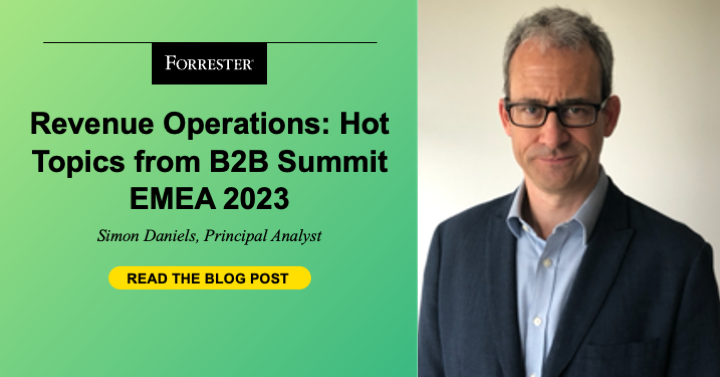As always, the Analyst 1-on-1 sessions at this year’s Forrester B2B Summit EMEA that took place in London a couple of weeks ago filled up fast! Providing delegates with the opportunity to speak with an analyst on a specific topic or particular piece of research, 1-on-1s always prove popular. Here are some of the revenue operations hot topics that came up this year.
What Are The Key Steps To Consider When Adopting Revenue Operations?
Revenue operations leaders tend to focus on internal measures of performance, efficiency, and productivity to align their teams, metrics, and initiatives. This internal focus though prevents delivery of superior buyer experiences to drive consistent growth. Achieve this by unifying resources (planning), processes and workflows, technologies, data, and insights across the revenue ecosystem. Crucially, avoid looking at adopting a revenue operations mindset as being purely about organization changes, which is too narrow a perspective. Instead, reframe RevOps as a highly configured, iterative commercial execution strategy designed to maximize customer value and commercial performance. Start with an assessment of organizational context, going beyond the org chart to consider what RevOps should achieve, the skills needed and how it will be delivered. Develop a roadmap, providing a vision that can be communicated about the future shape of RevOps for the business.
How Do We Move To Buying Groups When Adopting The Revenue Waterfall?
A key tenet of the Forrester opportunity-based B2B Revenue Waterfall framework is that purchase decisions are made by groups not individuals. As such, one of the first considerations for adopting the revenue waterfall is how to identify and manage buying groups. Primarily, this is achieved by listening for the signals that individuals exhibit about solutions in which they’re interested and then using functionality provided by most CRM systems to join these individuals together. Keep in mind, businesses selling multiple solution may be experiencing interest from more than one buying group simultaneously, and some of the same people might be in more than one group. Be sure to develop the buying group profile and capture the role of each individual within the group. As individuals are identified and added, it’s also important to treat them appropriately to the buying stage of the group and the role of that person.
What Is The Best Way To Measure Marketing Contribution?
Along with embracing buying groups when adopting the Revenue Waterfall, its time to kick the addiction to MQLs. At the same time, it’s a good idea to move away from lead source as the primary measure of marketing effectiveness, which we often refer to as the fastest way for CMOs to get fired. In reality, a closed deal will be the result of many marketing-driven interactions across the buying group and trying to attribute success to a single source doesn’t make sense. Similarly, existing customers renewing or purchasing new solutions are unlikely to be attributed to marketing at all. And new business that is sales sourced will not show up in marketing metrics, regardless of the contribution being made. Rather than source then, that marketing has made in achieving revenue targets. Drawing a baseline for where marketing contribution starts, using historical activity to determine where this line falls, marketers can measure the upside and claim credit for it.
How Should The Campaign Framework Be Deployed In Our Tech Stack?
Forrester has long advocated marketers adopt an integrated campaign framework to determine outcomes and efficiently execute coordinated marketing activity. Comprising a set of program families spanning reputation, demand, engagement, and enablement, campaigns are long-running and aimed at a specific buyer need. B2B marketers use a campaign hierarchy to provide clarity around each different component and ensure programs have a measurable objective, target audience, and tactics. So much for the theory, what about putting it into practice? Revenue operations practitioners employ a range of approaches across the revenue technology stack to manage campaigns, and since CRM systems tend to be the repository for activated demand these platforms are typically where marketing impact tracking and reporting takes place. Use the campaign hierarchy functionality provided by leading solutions to reflect the campaign framework (specifically, demand and engagement), with response or outcome captured at the lowest level. Where possible, use response coding to capture outcomes into specific campaigns and avoid generic or “evergreen” campaigns that make it hard to measure effectiveness.
How Should We Get Started With Generative AI?
There’s no doubt that the dominating topic of marketing conversations right now is generative AI (genAI), and this was certainly reflected at Summit. It can be overwhelming for marketers to know where to get started, the best applications for AI, and pitfalls to avoid. Generative AI, as the name suggests, is all about creation, be it text, images or even video. This is the preserve, needless to say, of content marketing and options abound for making a fast start here. Begin with ideation and use AI chat bots to suggest ideas for blog posts, content pieces or email subject lines. Longer form content can also be created as well as taking existing materials and summarizing, serialising or turning into social media posts. Take care though not to share with public chat platforms, such as ChatGPT, content that should not be in the public domain. Crucially, never submit personal data into an AI platform, as this is a breach of privacy compliancy. Regardless of the output from AI, make sure it is always reviewed by a human before publishing. A junior copywriter wouldn’t be allowed to publish without approval and, for the time being at least, neither should the machines!
***
As always, the wide range of queries that came up at Summit this year all point to revenue operations practitioners’ focus on efficiency, execution and measurement. Forrester clients can arrange a follow-up discussion to dive deeper into any of these topics, otherwise join us next year to ask us your questions!








